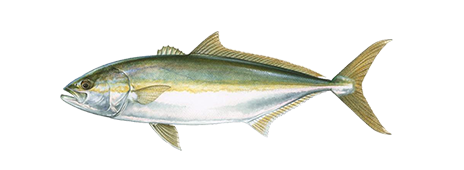California Yellowtail

Despite varying opinion about food value, the California yellowtail is generally highly regarded, with smaller fish receiving the better ratings.
HOW TO IDENTIFY A CALIFORNIA YELLOWTAIL
The yellowtail is easily recognized by its bright yellow tail and a characteristic brass colored stripe that runs along the median line of the flanks from the tip of the snout to the tail. It is closely related to the greater amberjack. It can be distinguished by the increased number of developed gill rakers, 21-28 on the first arch, while the amberjack has 11-16.
WHERE TO CATCH CALIFORNIA YELLOWTAIL
The California yellowtail occurs in some abundance throughout the Gulf of California and along the Pacific coast of North America from Baja California, Mexico to Los Angeles, California. Less commonly, it has been reported farther north, and on rare occasions, as far north as Washington. The yellowtail is a coastal, schooling fish that sometimes enters estuaries. It has been reported to occur occasionally in very large schools in the Gulf of California. It feeds predominantly in the morning and late afternoon on small fishes, invertebrates, and pelagic crabs. Small to medium size fish generally undertake seasonal migrations. Larger individuals are more solitary and less migratory. The following list includes additional details on where to catch this fish:
BAYS AND ESTUARIES COASTAL WATERS
NIGHT FISHING MAN-MADE STRUCTURES
REEFS, WRECKS, AND SHOALS SALTWATER AND TIDES
BREAKERS DEEP SHORE WATER
MERGING WATER PIERS, DOCKS AND PILINGS
ROCKY SEA FLOOR SURF AND SHORE
HOW TO CATCH CALIFORNIA YELLOWTAIL
The yellowtail is a fast swimmer and it will viciously strike baits and lures then make a long, hard run and sometimes two or three shorter runs before the fish is boated. Fishing methods include trolling or casting with live baits or with lures. The yellowtail’s habit of driving bait fish up against the shore makes casting from the beach possible at times. The advice of experts is to allow time for the bait to be swallowed, and then strike the fish hard. Fishing with circle hooks will increase the chance of a solid hookup. The following are fishing methods used to catch this fish:
DRIFT FISHING CHUMMING STILL FISHING
SALTWATER JIGGING FLY FISHING SURF CASTING
SPIN CASTING
CALIFORNIA YELLOWTAIL LURES, TACKLE & BAIT
The following are lures, tackle or bait that can be used to catch this fish:
CRABS FLIES SALTWATER LIVE BAIT
SPOONS CUT BAIT JIGS
SHRIMP SQUID